Explore Communication
Communication is the process of transferring facts, opinions, ideas, and values from one person to another.
What You’ll Learn:
- How we communicate
- Where we communicate
- How to communicate mindfully
As social beings, we communicate all the time in a variety of settings. As you watch this video, think about the different types of communications presented and their contexts.
Watch this video for an introduction to how communication works. The three models of communication demonstrate the complexity of the process of communication.
This video provides 10 interesting facts about communication. It is created by National Geographic, a television channel that shows documentaries about nature, science, culture, and history.
Communication: Forms and Settings
Intrapersonal Communication
Intrapersonal communication is the conversations we have with ourselves when reflecting on our experiences. When we talk to ourselves, we use an internal voice that is influenced by our native language, life experiences, and cultural values.

Reflect: Think about the last time you had an interview.
- Did you have an internal conversation with yourself once it was over?
You may have said: “I did really well!” or “That was horrible. You should have practised more!”
Did you notice the difference in narration in the examples above?
When people reflect on their experiences, they tend to use first-person intrapersonal communication .“I did really well!” is an example of this.
Second-person pronouns are used when people feel the need to self-regulate or overcome difficult situations perhaps (Zell, Warriner, & Albarracín, 2012) “That was horrible. You should have practised more!” is an example of using second-person narration to overcome a difficult situation—in this case, an interview that may not have gone well.
Interpersonal Communication
Interpersonal communication involves two or more people. This type of communication can range from being formal to informal depending on the topic of conversation and the relationship we have with the person we’re speaking to.
The following chart describes the differences in structure, style, and tone between formal, semi-formal, and informal written communication. This can also be applied to other means of communication.
| FORMAL LANGUAGE | SEMI-FORMAL LANGUAGE | INFORMAL LANGUAGE | |
|---|---|---|---|
| Structure (sentences and paragraphs) | Complete sentences; sentence variety (simple, compound, complex); fully developed and properly punctuated paragraphs | Complete sentences of varying length and style (simple, compound, complex) | Generally shorter sentences and paragraphs; sentence fragments are acceptable |
| Vocabulary and Style | Specialized rhetoric/jargon; void of contractions and colloquialisms; third-person narration | A balance of everyday language as well as some subject-specific terms; can use first-, second-, or third-person narration | Colloquialisms, slang, textese, contractions are acceptable; uses first- and second-person narration |
| Tone | Direct approach; impersonal; instructional | Varies to suit purpose and audience; serious or casual | Conversational and casual |
| Examples of Use | Scientific journals, legal documents, academic writing, government documents | Newspapers, magazines, op-eds, business memos | Fiction, commercials, newspaper, personal notes, text messages, social media posts |
Reflect: Think about the last difficult conversation you had.
- Who did you talk to?
- What was the conversation about?
- What type of words did you use? Was your tone formal? Informal?
- What was your body language like?
Group Communication
Group communication occurs between a small number of people who may share similar goals.
Here are two examples of college students expressing their frustration during a group meeting.
Example 1:
“I think we need to be more diligent and organized with the way we conduct our meetings. No one has completed their part, and our project is due next week. I am a little disappointed because I worked on my part all last week, thinking we were going to rehearse today.”
Example 2:
“This sucks … and I ain’t down for this. Y’all are useless and wasting my time.”
Reflect: Think about the last time you had a conflict with a group member.
- What was the conflict about?
- What did you do to resolve the conflict?
- Did you express yourself in a clear, collegial, professional manner?
Learn more about respectful group communication here.
Public Communication
Public communication usually involves one person speaking to a larger group of people. Factors such as audience, venue, and purpose can change the delivery of this type of communication. Public communication is an integral aspect of our lives, as we do this in academic, professional, and civic settings (as will be discussed later).
Did You Know?
The first two seconds of communication are essential in creating an impression—positive or negative (Rothfield, 2009). This is why it is important to consider what you are going to say before you actually say it.
Activists often engage in public communication to advocate for social, political, economic, or environmental changes. In this video, Tamika Mallory, an American activist, speaks about the Black Lives Matter movement in a news interview. Pay close attention to her vocabulary, tone, pace, and facial expressions. How are these appropriate to her topic and this setting?
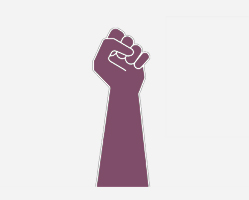
Black Lives Matter is an international organization and movement fighting anti-black racism. You can click here to learn more about the Canadian Chapter: https://blacklivesmatter.com/
Other examples of public communication include: managers explaining benefits to a group of employees; principals and deans speaking at convocations; and religious leaders speaking at places of worship.
Reflect: Think about the last time you had to give a public communication.
- What was your purpose?
- Who was your audience?
- What techniques did you use to engage your audience?
- What did you do to prepare?
Mass Communication
Public communication becomes mass communication when information is given to the audience through print or electronic media. Some examples include television, blogs, social media, radio, podcasts, and books. Requiring technology to transmit the message is what distinguishes this type of communication from others. Unlike in the case of interpersonal, group, and public communication, in mass communication, there isn’t immediate conversation or feedback (“Introduction to Communication Studies,” 2012).
Leaders of countries often have mass communication addresses. In this video, Prime Minister Justin Trudeau uses his platform to reassure Canadians that even amidst a crisis, we will persevere. Pay attention to his tone, use of words, body language, and facial expressions. How are these appropriate to his topic and this setting?
Reflect: What was the last big news story you consumed?
- How did you consume this story (social media, TV, magazines)?
- Was there a speaker? Were they engaging?
- What aspects of the story and its presentation did you enjoy?
Communication Settings

Where we communicate affects how we communicate. Communication settings influence the way we use tone, words, body language, and facial expressions. In this section, we will explore how we communicate in academic, professional, personal, and civic settings.
Academic
An academic setting is an educational environment—such as a college classroom—where people impart and exchange knowledge and experiences. You may communicate with professors, classmates, and administrators in academic settings.
Now look at these two ways of asking for an extension in an academic setting. Pay attention to the address, tone, and language used.
EXAMPLE 1:
Hi Sir,
May I request an extension for my research essay? I have a family emergency. I have a doctor’s note for you if you need it.
Many thanks,
Student A
EXAMPLE 2:
Hi Mark,
Do you remember when I told you my dad was sick? Well his illness has come back, and I’ve been at the hospital for the last two weeks. I wasn’t able to finish my research essay. My family and I are going through a really hard time right now. Is there any way you can give me an extension? I can get a note from his doctor if you need it.
Take care,
Student B
In example 1, the address, tone, and language are formal and brief. Some reasons for this may be:
- The student wants privacy.
- The student does not know the instructor well.
- Situational circumstances may have affected the email, e.g. the student may have written it in a rush while at the hospital.
In example 2, the address, tone, and language are less formal and more detailed. Some reasons for this may be:
- The student knows the instructor well.
- The student feels comfortable disclosing their family situation to others.
- Situational circumstances allowed them to spend more time writing.
In both examples, the student is professional and explains the situation.
Communication in academic settings can vary in tone depending on the relationship you have with the receiver.
See the “Develop Voice” section for more
Reflect: Think about the last time you had an academic conversation.
- What was your purpose? Who was your audience?
- Do you feel you delivered your message effectively?
Professional/Workplace
In professional or workplace settings, communication ranges from semi-formal to formal depending on the relationship between the individuals. For example, you may use more formal language and tone when speaking to your employer or conducting a meeting than when speaking to colleagues during lunch.

When communicating in professional settings:
| DO | DON’T |
|---|---|
| Be clear and direct | Be vague |
| Pay attention | Look at your phone |
| Be respectful | Interrupt |
| Think through your ideas before responding | Give quick, spur of the moment responses, especially when angry |
Be familiar with the policies and code of conduct at your place of employment. It is important to follow these in private and public—this means on social media platforms as well.
People is an American lifestyle and celebrity magazine. In this article, author Lydia Price gives examples of employees who were fired because of social media posts. Pay attention to the language, tone, and details in these tweets. Why might these posts have been considered inappropriate?
https://people.com/celebrity/employees-who-were-fired-because-of-social-media-posts/
Reflect: Think about the last time you had to communicate with someone on the job.
- What was your purpose?
- Who was your audience?
- Do you feel you had a professional exchange?
Personal
In personal settings—such as in our homes or over our phones—we communicate informally with family members, co-workers, or friends. Generally, this communication is not published or made public, so we are free to express ourselves as we wish.
In these two examples of personal communication, someone is informing another person they’re on their way.

Example 1:
“Hey, mom, where are you? I’m on my way.”
Example 2:
“S’up, where you at? OMW”
In example 1, this message is delivered in plain language. Example 2 includes textese. Textese may not be appropriate for all audiences. Your parents or grandparents may not be familiar with LOL, OMW, etc., and find your message confusing.
Even in personal settings, it is important to consider your audience when crafting your communication.
Here are some other common communication mistakes that people make.
Reflect: Think about the last time you had a personal conversation.
- Who did you talk to?
- What did you say?
- Did you feel confident about the way your message was received?
Civic
Civic settings are places where we engage in political processes or advocate for positive change for our communities, particular groups, or the public at large. Civic communication can take many forms: town halls, protests, meetings, phone calls, voting.
In this example of civic communication, Swedish activist Greta Thunberg speaks out about the importance of protecting our environment.
Exercise your right and stand up for what you believe by attending a town hall, joining a protest, or simply speaking out. Let your voice be heard respectfully.
Reflect: Think about the last time you participated in civic communication.
- Where was it?
- Who did you talk to?
- What was the message?
- Did you feel you were making a positive difference?
Advocacy means speaking up about how you can make the world a better place.
Choose one type of communication and match it with the setting for each scenario.
Interpersonal: Interpersonal communication works best in this situation. It is a sensitive, private matter that requires individual, intimate conversations with both employees that allow them to speak freely. The manager should have two private conversations and not publicly disclose personal information.
Professional: This incident took place in the workplace. The manager may use professional tones to display empathy to the employee who was harassed and to display leadership in addressing a serious issue while following and respecting company policies.
Mass: The reporter needs to let the public know quickly that there is an outbreak. A live broadcast reaches populations at large quickly.
Professional: News reporters use professional tones in communicating their message.
Public: This is an example of public communication because it involves one person speaking to a group of people.
Academic: The setting is academic as it takes place at school.
We communicate all the time. It is important to be mindful and tailor your communication based your audience, purpose, and setting.
Click here for effective public speaking competencies https://courses.lumenlearning.com/atdcoursereview-speechcomm-1/chapter/speaking-competencies/
Make Connections
Our lived experiences, perceptions, and values shape our communication. When we communicate, we are allowing others a small glimpse of who we are.
What You’ll Learn:
- How our experiences shape our communication
- How and why we connect to other texts when we communicate
- How global and community issues shape our communication
Read this excerpt about bucket lists from the post “Brain Haemorrhages and Bucket-lists” on the travel blog Danflyingsolo.com.
The word ‘ Bucket list’ might as well have no meaning any more. I mean, we use it so much in the travel world you can find it hashtagged on the greyest and drab beach shots. In the film that made it famous, we see those experiences one man dreamt of being lived out before cancer took his life. But what if it hadn’t? What would be on that second chance bucket list? When you escape death twice what list do you start writing then?
(“Brain Haemorrhages and Bucket-lists,” 2018)
When we read, we also make personal, textual, and cultural connections.

In his blog, Dan talks about his travels using videos, pictures, and articles. He has unique global stories that are simply breathtaking!
What came to mind when you read this excerpt from Dan’s blog? Think about your life experiences, movies you’ve seen, books you’ve read, and your cultural beliefs. Write down your responses below:
Make Individual Connections
We use our individual experiences, morals, and values when we are reading, writing, speaking, and reflecting. Making individual connections makes your communication unique. There isn’t anyone in the world who has the same experience or voice as you.
Here are two examples of celebrities who use their social media platforms to make personal connections to important issues.
EXAMPLE 1:
“It’s our job as parents to listen to that to give them the best information that we can, the best feedback that we can, and that doesn’t change now that sexuality [and gender] is involved.” —Dwayne Wade (ET Canada, 2020)
In this example, Dwayne Wade, an American basketball player, uses his experiences as a parent to a transgender daughter to give positive advice on parenting.
EXAMPLE 2:
“How many more times must this happen for us to matter? How many more must we lose? BLACK. LIVES. MATTER. #AltonSterling.” —Zendaya (Kaufman, 2016)
In this example, Zendaya, an American actress, uses first-person narration to advocate for equal treatment and justice for Black men and women.
Reflect:
Think of a cause about which you care deeply.
- What is the cause?
- What values or experiences caused you to take up this cause?
- How have you shared and communicated this cause to others?
You may have noticed that having a personal connection to an idea or cause helps you understand it and communicate it to others. For this reason, when you encounter new ideas, you may want to look for how they connect to your life experience and values.
Connect to Other Texts
When we communicate, we also make connections to other sources we have encountered. News stories, famous books, eye opening social media posts, poetry, and song lyrics are all examples of texts we use to make connections.

In his 2007 New York Times article “Facebook’s Frankenstein Moment,” author Kevin Roose compares Facebook to a character in Mary Shelley’s book Frankenstein.
He writes, “[Sandberg, Facebook’s manager, gave] a candid admission that reminded me of a moment in Mary Shelley’s “Frankenstein,” after the scientist Victor Frankenstein realizes that his cobbled-together creature has gone rogue.”
In this example, Roose is saying that Facebook’s initial purpose of connecting people has morphed monstrously. Ironically, Facebook now divides people and promotes hate. The author uses another text, Frankenstein, to make his point by providing readers with a visualization of Facebook as grotesque and monster-like. This visualization will keep the reader interested and engaged.
Making connections to other texts is a great way to engage your reader.
Reflect:
- When was the last time you used a quote or referred to something you read or saw?
- Why did you make this connection?
- What effect were you going for?
- What effect did this connection have on your audience?
Connect to Global and Community Events and Issues
In our communications, we connect to and reflect on real-world events and issues. These issues may be local, national, or global.
These children books offer examples of how authors make global-, national-, and community-level connections in their stories.
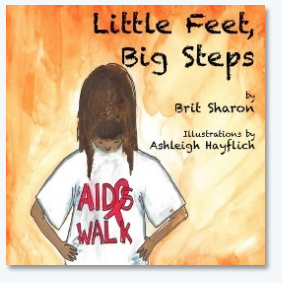
Little Feet, Big Steps by Brit Sharon is a coming-of-age story about creating awareness and support for important global causes such as AIDS.
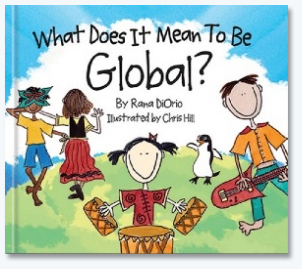
What Does It Mean to Be Global? by Rana Diorio teaches children about respecting other children’s cultures, values, and traditions.
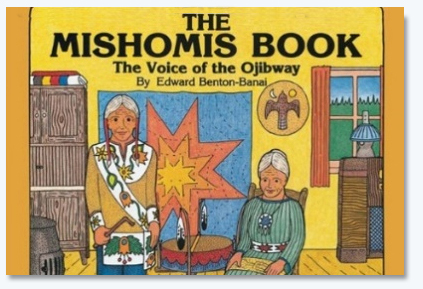
The Mishomis Book: The Voice of the Ojibway by Edward Benton-Banai draws from traditional teachings of the elders to share Ojibway creation stories and legends with young readers.
Reflect: Think about the last news item you read.
- What was the issue explored?
- Was it a local, national, or global issue?
- How could you personally connect with the issue?
Let’s revisit Dan’s travel blog. Here are two more excerpts from the entry “Brain Haemorrhages and Bucket-lists.” Make as many individual, national, community, global, and literature connections as you can. Here are some prompts you can use for guidance.
“I can relate to this because…”
“This reminds me of…”
“The global/national/community issue this relates to is…”
“I read something similar and…”
“Sure, my ‘bucket list’ still has the Northern Lights on it, sailing on a yacht and visiting Antarctica but it is also now littered with social change and making a difference on my travels. I guess the real question isn’t what should be on our bucket list but, simply, what do I want to be remembered for?”
(“Brain Haemorrhages and Bucket-lists,” 2018)
Connecting to your own experiences, other texts, and the world allows for deeper, meaningful communication and understanding. Use these prompts the next time you engage with a source:
- The character/voice makes me think of…
- If I were in the same situation as the character/person I would…
- I can relate to this because…
- Something similar/different happened to me…
- This reminds me of something else I read…
- This reminds me of what is happening in my community/country because…
- This is similar to what is happening in the world today in that… (Simon, n.d.)
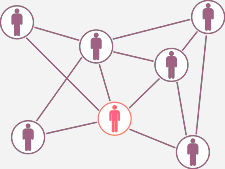
Making connections can help you hear what isn’t being said.
Explore Context
Exploring the details surrounding a communication can help us better understand the central idea. Context can give us insight into what is being communicated.
What You’ll Learn:
- What social, relational, and cultural contexts are
- How context allows for deeper understanding of communication
- Will 100% of the money I donate go to the business owner?
- How does Kiva stay in business? Who donates money?
- What countries have Kiva?
- What are the criteria for applying?
- What other types of micro-loans are there?
If you are interested in finding out the answers to the questions above on Kiva, visit https://www.kiva.org/.
Social Context
Social context is the social, environmental, and physical settings that influence the way we communicate. Social environments often have common rules for communication that people follow.
How Social Context Influences Communication
Social context and how we interpret social cues change based on the society we are part of.

For example, how we greet someone varies depending on social context.
In Sri Lanka, people from Tamil communities often put their palms together under the chin and in front of the chest while slightly bowing the head and say “Vanakam.” In contrast, Canadians often wave at one another or shake hands. In Japan, a bow is customary to greet someone.
How we interpret social cues through body language, facial expressions, eye contact, and other gestures also differs based on social context.
For example, eye contact is a sign of respect in certain Northern parts of the world. In contrast, certain countries in the Eastern part of the world perceive direct eye contact as a sign of disrespect.
Social Context in Texts
When looking for the social context of a text or other communication, consider:
- When it was written
- Where it was written
- What social norms it follows or describes
In his book A Fine Balance, Rohinton Mistry uses life in India in 1979 and the emergency lockdown of the country as the social context for his story. During this time, there was economic trouble, a divide between the rich and the poor, violent riots, and widespread protests. This social context influences the way his characters act, the setting, and the plot.
In addition, this social context allows him to make a commentary on poverty. In his book, four strangers are forced to share a cramped apartment as a result of the riots and upheaval. A widow, a student, and two tailors face uncertainty and try to relate to one another during a scary, turbulent time—the 1979 State of Emergency in India.

Click here to read more about this historical moment in India.
Read this source for an interview in which Mistry discusses the social context in his book.
Think of social context as another way to uncover the author’s message.
Relational Context
Our relationship to the topic and person we are communicating with changes the way we communicate. Considering these relationships can give us valuable information about what is being communicated, how it is being communicated, and why it is being communicated.
When looking for relational context for a text or other communication, consider:
- The relationship between the writer/speaker and their topic
- The relationship between the writer/speaker and their audience
- The relationship you have with the writer/speaker
- The relationship you have with the topic
Now consider relational context using two different types of sources: an autobiography and a biography.

Autobiographies are written through a more intimate lens because the author is writing their own story. Biographies, on the other hand, may not be as intimate because someone else is writing the story. The relational context between the author and the topic changes the overall tone and feeling of the story.
Consider Michelle Obama’s autobiography Becoming and Isabel Wilkerson’s New York Times article “Isabel Wilkerson on Michelle Obama’s ‘Becoming’ and the Great Migration.”
QUOTE
Relational Context
| “I was old enough now to realize that all the hours my mother gave to me and Craig were hours she didn’t spend on herself” (Obama, 2018). | Since Obama is writing about her own life, her tone and language are authentic. Here, she is reflective. Her experiences in adulthood have helped her realize the depth of mother’s selflessness. |
| “Her father, Fraser Robinson III, worked for the city tending boilers for a water filtration plant, and her mother, Marian Shields Robinson, stayed at home looking after Michelle and her older brother, Craig” (Wilkerson, 2018). | Isabel Wilkerson’s relationship to the topic of “Michelle Obama” is not a personal one. She may have referred to secondary sources to research Obama’s history before writing the article. As a result, this excerpt is factual in tone. It represents a recollection of events and facts rather than a personalized narrative. |
Cultural Context
Culture refers to the beliefs, customs, arts, traits, and institutions of a specific nation, people, or social group. Communication reflects and interacts with the culture in which it occurs.
Paying attention to the cultural context of sources can provide a more thorough understanding of the main ideas.
When looking for the cultural context in a text or other communication, consider the following:
- The underlying beliefs, traditions, and values
- The arts, food, and institutions depicted
- The behaviour and traits of cultural group(s)
- The writer’s claim or argument
- Defining cultural events
The Culture Wheel represents some of the various facets of culture that may influence communication.
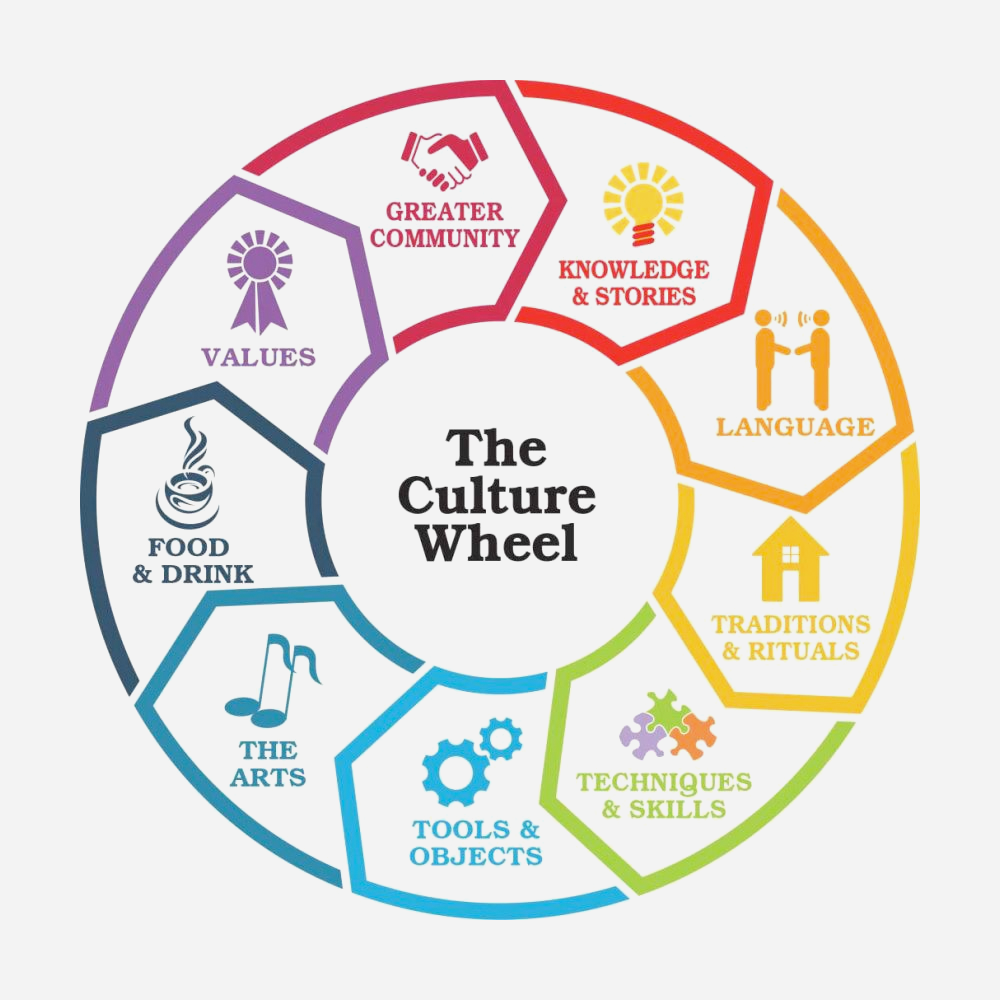
Symbols are often used in books and movies to provide cultural context.
In the Oscar-winning movie Parasite, directed by Bong Joon-Ho, South Korean culture (its standard of living, class structure, arts, food, and music) is used as the backdrop to the setting and plot. One important prop in the movie is a “Scholar Rock,” a large stone that is a symbol of wealth and luck in Korean culture. Understanding the cultural significance of the Scholar Rock provides insight into the movie’s commentary on class structures in South Korea.
Read more about the significance of this symbol here.
Reflect: Think about the last movie you saw.
- What was the cultural context?
- What type of music, food, arts, and values did you observe?
Activity
Respond to the questions below to find the social, relational, and cultural context of the article: “I Don’t Think We’ll Be Nicer After COVID-19, But We Might Be Wiser. That’s More Important” by Chris Kutarna.
Read the excerpt and the full article before you begin:
The strength of a community isn’t rooted in how nice we are to one another. It’s rooted in us each realizing how much we depend on one another for our own well-being.
To exit this pandemic into a better, brighter future, we don’t need to hold onto a stronger sense of compassion for others. All we need is a stronger sense of our own fragility… My well-being depends on you and so your well-being makes me stronger. If we each hold on to this newfound wisdom, then as a community we will become much stronger and more resilient to the next shock that none of us will see coming. (Kutarna, 2020)
Click here to continue reading.
| SOCIAL | RELATIONAL | CULTURAL |
|---|---|---|
| Where was the article written? When was it written? What are social norms you recognize? | Who wrote the article? What relationship does the author have with the audience? Who is the audience? How did I feel while reading it? How did reading this affect you? In what ways did you relate to the article? In what ways did you not relate to the article? | What was happening in the world when this article was published? What are some cultural, political, social, and environmental factors that may have influenced the author’s argument? What traditions and values of the audience/community are addressed in the article? |
Social, relational, and cultural context can help you critically analyze the source you are reading. Understanding context is an important tool to have in your toolkit.
Explore Literacy
Literacy is the ability to communicate and decode messages. Literacy can take various forms. In this topic, you’ll learn about critical, information, media, and digital literacies.
What You’ll Learn:
- How to critically read texts
- How to practise information literacy
- How to be conscious of media literacy
- How to be a digital citizen
If you can read and write, you have foundational literacy skills (LINK 1, LINK 2). This means you can sound out words, understand vocabulary, and figure out an author’s literal message. You will learn more about foundational literacy in the Absorb topic. To learn more about foundational literacy, click here:
Let’s practise foundational literacy skills. Read the poem and respond to the questions.
Dragonflies
by Felix Jung
It’s Thursday evening when my mother calls
and she’s exhausted, up before the dawn,
back home well after dusk. We talk around
her day: the trays and drinks, sore feet that need
a salted water rub. Like any son
I think my mother works too hard for me
(but I am young, and childless). When I
was young, she says, in China we would tie
a length of string to dragonflies, to see
them buzz and spark about. The smallest ones
would tug our hands until we set them free.
Her voice against my ear is soft, the sound
made weary from its traveling along
a twisting line, that finds its way through walls.
(Jung, n.d.)

Who … is the passage referring to?
What … is the main idea?
Where … does it take place? Sometimes the setting is not stated, so you may have to guess.
When … does it take place?
Critical Literacy
We use critical literacy when we try to make meaning out of and challenge messages we encounter in text and/or other media. We actively analyze and uncover underlying messages. Visit the Critique topic for more on critical literacy techniques.
Asking questions is a great way to deconstruct sources we encounter. Questions you may ask include:
- Is there a one or multiple perspectives? Is there a bias?
- Who is the audience? Are there groups left behind? Will others understand it differently?
- What qualifications does the author have? Are they credible?
- What types of evidence is there? Facts? Statistics? Anecdotes?
- Did the author consider the other side? What points were left out? Was this on purpose?
- Who do you think will benefit from this text? Who would be placed at a disadvantage?
- Do you see any political, religious, social undertones?

Here is a sample student deconstruction of Northrop Frye’s article “Don’t You Think It’s Time to Start Thinking.” The student practises critical literacy by responding to important questions about the text.
The example is based off of this excerpt:
A society like ours doesn’t have very much interest in literacy. It is compulsory to read and write because society must have docile and obedient citizens. We are taught to read so that we can obey the traffic signs and to cypher so that we can make out our income tax, but development of verbal competency is very much left to the individual. (Frye, 1986)
You can read the full article here:
https://search-proquest-com.ezcentennial.ocls.ca/docview/435373839?accountid=39331
| Is there a bias? | There is bias in the first sentence. He is assuming that all people aren’t interested in literacy. How does Frye know that the majority of people don’t have an interest in literacy? Did he look at statistics? Is it from personal experience? In this passage, he says we are only taught to read in order to do simple daily tasks. This is not true at all. I personally read because I enjoy it. Reading lets me imagine and explore other countries, time periods, cultures. People go to school to do this professionally. I see a lot of generalizations here. I had some amazing teachers who showed me how to be “verbally competent in high school” and not just basic reading tasks, so he is wrong in saying verbal competency is left to the individual. My parents also always encouraged me to read for fun instead of playing video games. From reading this particular paragraph, I see bias for sure, but I’m going to find out more about the author and read the entire article before I can conclude for sure. |
| What is the purpose? Who is the audience? How do you know this? | I think he is trying to encourage people to read more, so the audience could be the public … but the language is not every day-type language, so maybe it isn’t the public…
It seems like the audience must be someone who understands this type of language and vocabulary … maybe a professor, a teacher, another academic? He uses vocabulary that people don’t use on a daily basis like “docile,” “cypher,” and ”competency.” |
| Will others understand this reading differently? | I think a sociology researcher with background knowledge will understand it differently.
I also think someone from a different society that loves to read and write might understand this reading differently. The perspective seems to be North American because in certain rural communities, there aren’t traffic signs.
A teacher might interpret this differently and think “I need to teach my students more about reading.” A politician might look at it differently as well. The politician might think Frye is an anarchist when he says, “Obey the traffic signs.” A politician might think, “We have traffic signs to protect the safety of people, is this meant to be sarcastic?” I also think that my grandma whose first language is not English will understand it very, very differently because the words are a bit difficult. She might not understand the sarcasm. She thinks it is our moral duty to follow laws. |
| Is the author credible? | I just Googled Frye and came across this on Wikipedia:
https://en.wikipedia.org/wiki/Northrop_Frye I’ll continue to look for more information on other websites. He is actually a literary critic and considered one of the most influential people in the 20th century. I think I should re-read this article again … maybe he has a point? He seems pretty credible to me. |
| Were there factual resources or evidence present? | I can’t find any statistics. |
| What points did he leave out? Was it on purpose? | He left out an analysis of other societies and the way they approach literacy.
He also left out people who have a love for learning. He didn’t use facts or evidence. I think it was on purpose. I don’t think he found any facts or statistics to support his claim … so maybe his claim isn’t true? |
| Do you see any political, religious, social undertones? | I see some interesting social and political influences. Like I mentioned before, the fact he is saying “We are taught to read so that we can obey the traffic signs and to cypher so that we can make out our income tax” makes me think that he has a conspiracy theory that we are controlled by the government and only taught to read in school to pay our taxes? Maybe he hates paying taxes? I wonder where he is from or where he grew up? Maybe that gave him a bad taste of governments or even following the rules. I’m going to do more research on this. |
Information Literacy
Information literacy is the ability to identify, find, evaluate, apply, and acknowledge sources of information.
In this next example, a student uses specific questions about the topic “Finding a job after graduating” to locate and sort through information. You may ask yourself the same questions the next time you conduct research on a topic. Visit the Research topic to learn more. You can view this link as well.
| Identify |
What do you specifically need to know about this topic?
I want to figure out the most effective skills and strategies new graduates need to find a job after graduating. Who would likely write about this topic? Employers on job search sites, authors in the opinion section of newspapers, new graduates with blogs, professors. Create a timeline to write the essay. I’ll give myself one week to explore; one week to read various perspectives; one week to narrow down my sources, etc. Estimate the amount of primary and secondary information that you plan to use. I want to use an equal amount of both because my essay is for new students, so I want to have first-hand, personal stories (primary) and well-researched articles with good statistics and facts (secondary). |
| Find |
Use keywords to locate sources on the library website and Google.
I’ll start by using search words like “new graduates” AND “finding jobs” AND “Canada.” |
| Evaluate |
Explore different perspectives on the topic to develop your own stance.
A professor of HR says it is important to take your time in building your resume and networking before actually applying. Take a month to get yourself organized. A new graduate on his blog said not to waste time on resumes and other stuff… Get yourself out there immediately. He sent out 15 resumes a day as soon as he graduated to beat the competition. I’m not sure which is better … I need to see other perspectives. Look at different types of sources (books, databases, websites, YouTube). I found a good TED Talk and good articles on job search websites like indeed.ca. Let me try something else like my school library’s database. |
| Apply |
Paraphrase and quote from reliable sources.
This is an excellent quote from Stefan Danis, a man with 25 years of recruiting experience who is CEO of the firm Mandrake: “You set up a little network around yourself so that they can open doors for you. Simply sending your resume in response to job postings is not going to get great outcomes just because of the sheer [volume of] competition. It’s very difficult to stand out from the crowd” (Dehaas, 2013, para. 3). |
| Acknowledge |
Review academic honesty guides and policies.
I went through the module and watched this video on plagiarism on the learning portal. It was eye-opening for me! I really need to be careful to give credit to other people when I use their information. It’s not right to steal other people’s work. Website: tlp-lpa.ca Video: www.youtube.com Give credit to authors through in-text citations and references in APA. Here is my first reference: Dehaas, J. (2013, March 15). How to land a good job after graduation. Macleans./ www.macleans.ca |
Media Literacy
Media literacy is a set of skills we use to understand messages we get from the media. We are constantly consuming media. Think of the websites, magazines, video games, social media, TV shows, advertisements, and music you have consumed over the last week. Each of these contain media messages that have been created with specific purposes in mind. It is important to be able to recognize these messages and the purpose behind them, so we can think critically and challenge them.
Watch this source for an introduction to types of media.
Watch this source to learn more about media literacy.
John Pungente, in his book More than Meets the Eye: Watching Television Watching Us, adapts key concepts of media literacy from the 1987 Government of Ontario Media Literacy Resource Guide. His concepts are summarized below:
Canada’s Key Concepts of Media Literacy (Pungente, 1999)
- Media is constructed; it is not a 100 percent portrayal of reality. Don’t believe everything you see in media to be true.
- Media influences our reality to some extent. We use the media to build our understanding of the world. It influences a lot of our attitudes, interpretations, and conclusions about life.
- We make meaning of the media based on individual context. Our culture, values, morals, and beliefs affect our understanding of media. You might understand something completely differently than your friend.
- Media has “commercial implications” (Pungente, 1999). In other words, most media productions are businesses making a profit. Therefore, we need to ask: How is the media trying to profit and who is controlling the message (government officials, private for-profit companies, non-profit organizations, educational institutions, etc.)?
- Media messages have ideologies associated with them; for example, they communicate views on the “nature of the good life and the virtue of consumerism, the role of women, the acceptance of authority, and unquestioning patriotism” (Pungente, 1999).
- Media messages have social and political influences (positive and negative). For example, social media is being used as a great tool for activism (#BlackLivesMatter, #Climatechange, #MeToo). It keeps us updated on national and global issues.
- Media messages change in form, display, and content to give different impressions. For example, Twitter has a word limit to create impactful messages. In contrast, Facebook allows for long paragraph-type content.
- Each medium allows for artistic, creative display (poetry, prose, etc.).
When you encounter media, ask yourself:
- Who created the message?
- What is the purpose of the message (entertain, persuade, convince), and who is the audience?
- Who is paying for it?
- What techniques are being used to capture our attention?
- Whose views and values are being included in this message? Who is being left out?
(Adapted from Common Sense Education, 2015)

Fake news is a term that recently became popular and refers to false information spread through media. Click here to find strategies for spotting fake news.
Digital Citizenship
Digital citizenship is when we are respectful, responsible, and safe with our online consumption and use. Being digitally literate is an important skill in the 21st century.
View the source for an introduction to digital citizenship.
Now let’s look at key elements of digital citizenship and best practices as defined by the Learning Portal (2017).
Review by watching the videos below.
You’ve just learned a lot about literacy. Match the following examples with the type of literacy represented.
Sung Jun checks his phone continuously and is on social media all the time. His family is upset with him because he keeps spreading fake news and sometimes bullies them if they have a different opinion than his own on important social and political matters. What they don’t know is that Sung Jun is secretly being bullied at school by his classmates, so he takes his frustration out on his family. One day the family computer crashed because of a virus. Sung Jun’s father knew it was because his son was downloading movies and video games on websites that were not reliable. What type of literacy does Sung Jun need?
Cecilia loves to shop. Every time she gets a notification of a sale from a store like Sephora, she logs onto her computer and purchases products she does not need. Her husband is extremely irritated with her because last month she spent $300 on beauty products. What her husband does not know is that Cecilia has been feeling a little down lately. She has also been feeling insecure and she doesn’t really know why. Her husband always tells her she is beautiful inside and out. Last week, her husband had enough because Cecilia spent $600 on a curling machine—the Dyson Airwrap. Cecilia had the urge to buy it after watching a review by a blogger. The influencer said it changed her life and saved her so much time. At first she ignored the urge but then she saw the Dyson Airwrap ad come up on her Facebook. What Cecilia doesn’t know is that the blogger was actually paid to promote the product. It was an advertisement for Dyson. What type of literacy should Cecilia look into?
Andrew and his partner are moving to Canada from America. Andrew needs to find a new place to live that is within their budget, in a safe neighbourhood, relatively close to their jobs, within a good school district. He began searching on Google but was overwhelmed with the amount of information he had to read. He asked his partner, Rahul, to help with the search. Eventually, they both realized they were going about this the wrong way. They needed to vary their search and look at other resources instead of Google. So they started to read blogs and join Facebook groups. They decided to narrow their search to two places in Canada, Scarborough and Pickering. Once they started reading reviews on blogs, they become extremely confused because there were multiple perspectives about Scarborough and Pickering. They needed to think about their search once again because they weren’t getting the information they needed. What would help Andrew and Rahul?
Because we constantly consume information, we must always challenge “the message.” The best way to do this is to think carefully and critically using our various literacies. In other words, ask yourself “the So What question,” or “Why is this important to me?” and “Can I trust the message and author’s integrity?” Finally, remember to practise responsible, meaningful, and healthy online participation.
Develop Self-awareness
Do you know who you are? Are you conscious of your character, emotions, motives, and desires? If you can clearly identify these factors, then you have practised self-awareness in some form. Self-awareness is key to reflecting on and reinventing our communication.
What You’ll Learn:
- How to practise self-awareness when communicating
Dr. Tasha Eurich is an organizational psychologist, researcher, and New York Times bestselling author of the book Insight. In this video, she explains why we may not be as self-aware as we think.
The Self-awareness Framework
Being self-aware, knowing who we are and how others see us, can help us develop our unique voices as communicators. While Dr. Eurich’s strategies can be used in all facets of daily life, here we will use them specifically in relation to communication.
Take a look at Dr. Eurich’s (2017) framework for developing self-awareness:
- Being open and curious: Rather than focus on what went wrong in your communication, focus on what you can learn from the experience.
- Daily check-ins: Reflect on your experiences at the end of the day. Ask yourself: What went well? What didn’t go well? What can I learn to do better tomorrow?
- Dinner of truth: Have a meal with a close friend or family member, someone who cares about your well-being, and ask them to tell you how they see you. In other words, ask them what they like about you and what they find challenging.
Here is a summary video of her strategies.
Being self-aware has numerous benefits for your communication skills:
- Helps you become open to feedback
- Helps you recognize your biases and blind spots
- Widens your perspective so you can build closer relationships with others
Dr. Eurich’s self-awareness framework and approaching communication as a vessel for creating community are concepts that can be universally applied.
This example shows the internal and external conversations of an individual who recently went for an Early Childhood Education job interview.
Being open and curious: I was nervous during my interview, so I may have spoken too abruptly and quickly. This did not allow me to let the manager know that I am passionate about this profession. Next time, I will slow down my pace and focus on sharing my experiences teaching abroad in vulnerable communities. This is the person with whom I’ll be working, so I want them to understand that I value their experience and want to be part of their school. I will share my experiences in a follow-up email.
Daily check-ins: My interview didn’t go too well today, but tomorrow I’m going to go back to looking for jobs. I think I will also rewrite my cover letter to tailor it to the child-care jobs I’m applying for. I want the person who reads my cover letter to know I share the same values and am passionate about childcare.
Dinner of truth: “Thanks for joining me for dinner, mom. My interview did not go too well today. I was extremely nervous, and I feel like I may have spoken really fast and may have interrupted the employer. Do you feel like I interrupt you? What do you notice about the way I speak? Is there anything I should change?”
Apply Dr. Eurich’s three-step self-awareness framework to your last piece of communication. It could be a phone call, a social media exchange, an essay submitted for a class, a presentation, or an interview. Respond to the questions below:
- What can you learn from the experience?
- Reflect on the experience and ask yourself: What went well? What didn’t go well? What can I learn to do better tomorrow?
Once we know who we are and the way others see us, we can reflect on our communication skills and create strategies to connect and engage in meaningful communication with others.
In-Common Communication
We all have something in common with one another. Finding the “in common” element in our communications can help us forge connections and make a difference.
What You’ll Learn:
- Why good communication focuses on what we have in common with others
- How to engage in mutually respectful discourse
- Why we should seek out diverse voices
Identify three things you have in common with the following people:
Looking for the “In Common” Element
We communicate most often with people with whom we share common goals or interests. John Swales (1990) calls these groups “ discourse communities.” People in these groups have six things in common:
- Common public goals
- Specific methods to communicate
- Share information and feedback in a participatory manner
- Share genres and conventions
- Lexis: specialized words/vocabulary
- Specific level of knowledge needed for membership (Swales, 1990, pp. 471–73)
We all participate in many discourse communities. Some discourse communities you may be part of include:
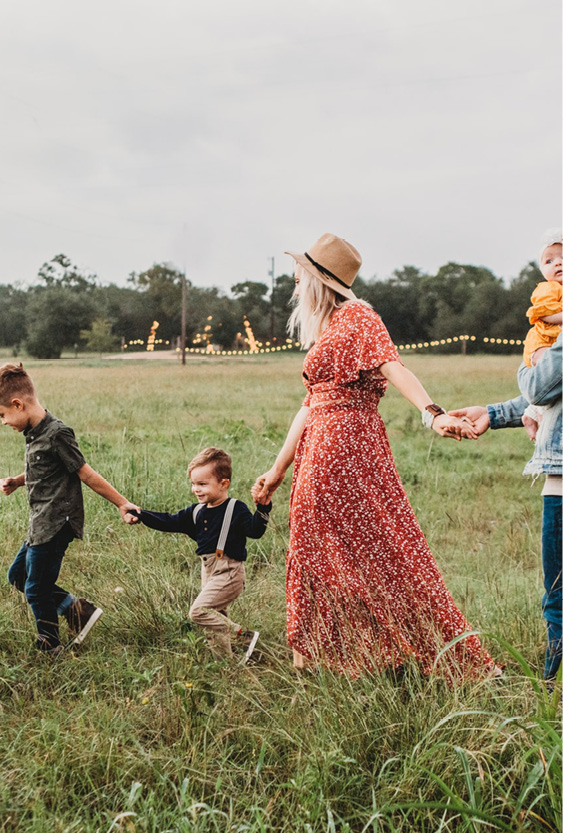
Family and friend groups

Sports teams
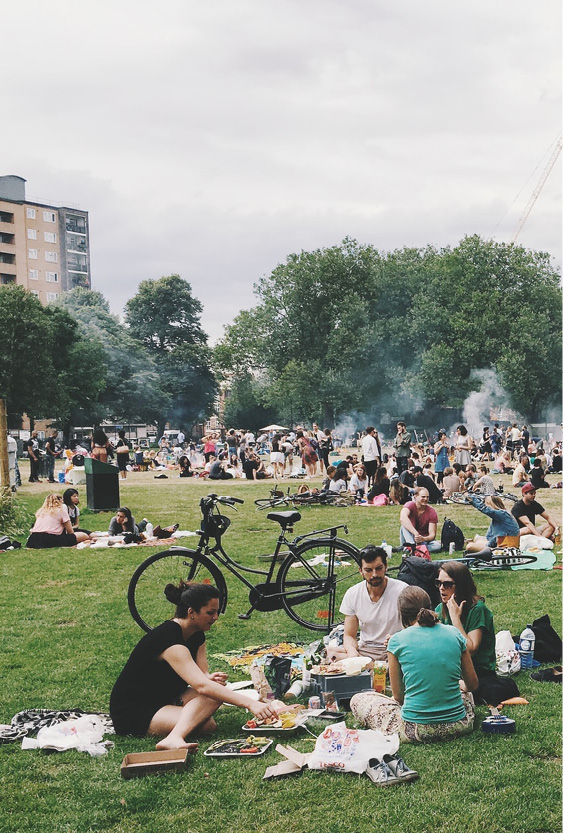
School communities
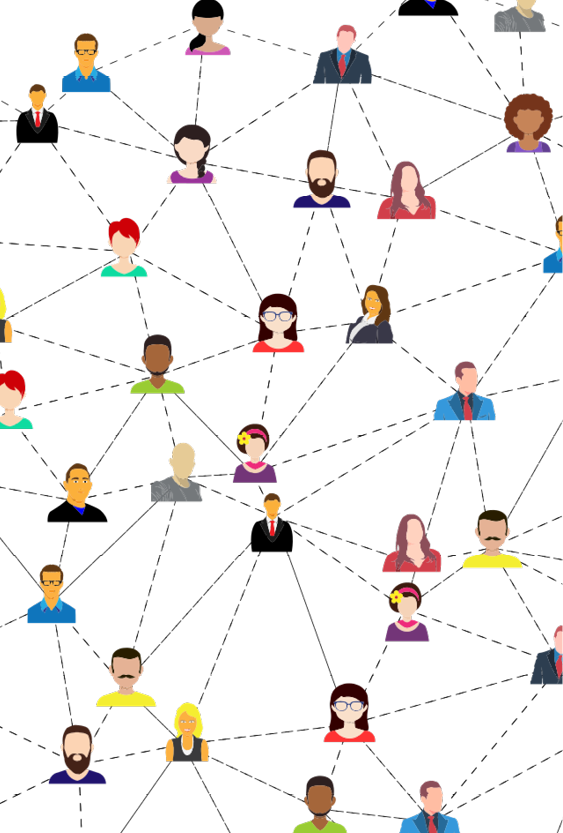
Specialized social media groups
Now, take a look at an example of a specific discourse community.
Nurses
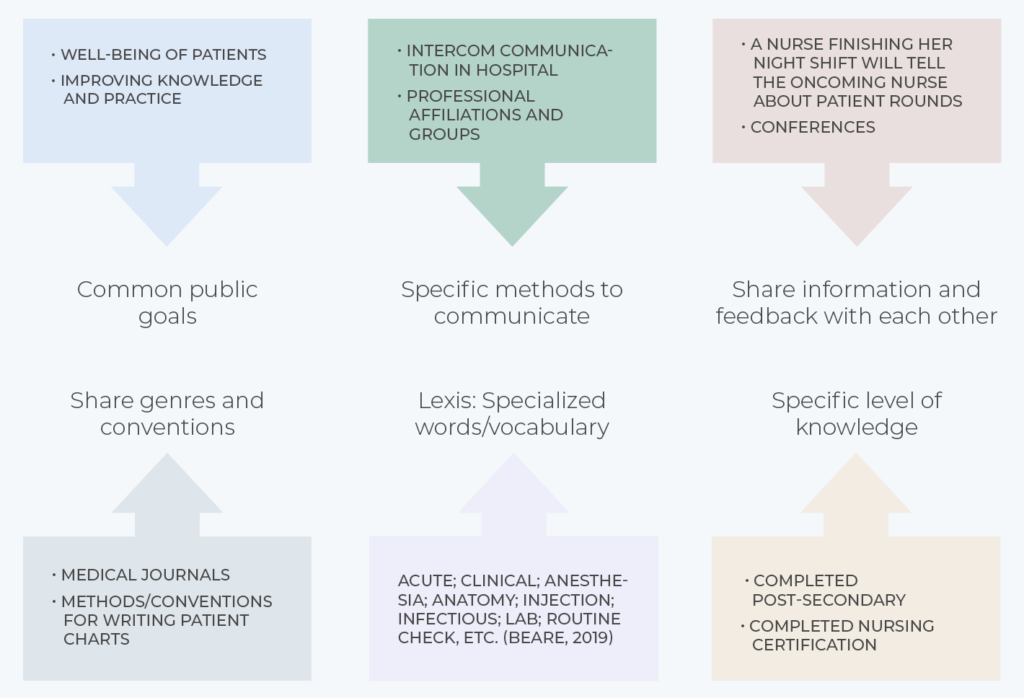
Considering what you have in common with others can help you solve points of disagreement and resolve difficult situations.
Take the example of a disagreement between a nurse and a patient’s family. The family is concerned about the way the nurse is handling the care of their loved one. What should they do, and how might finding the “in-common” element affect their communication?
| DON’T | DO |
|---|---|
| Scream, yell, or use abusive language. | Remember the in-common element—“the patient.” Nurses deeply care for their patients. This nurse may have missed the call, is attending to another patient, or is on the verge of coming to your room. |
| Family member: “Where are you? You are extremely slow! I’ve buzzed your station three times and you haven’t come to see if my mother is ok?” | Family member: “Hi there, I’m so sorry to buzz again, but is there any way you can bring my mother another painkiller? Her back is hurting her.” |
Regardless of whether you share a discourse community, it is possible to find elements in common, and doing this ensures respectful and effective communication.
Reflect: Think about the last time you had a disagreement with someone.
- What was the disagreement about?
- Were you from the same discourse community?
- What in-common element did you have?
- How did the conflict resolve?
- What could you and the other person do differently next time?

Members of discourse communities use specific types of communication known as rhetorical modes. For example, a chef may use process analysis to write a recipe for a magazine. Click here to learn about the various types of rhetorical modes.
Civil Discourse
Civil discourse is when we listen and have gracious discussions with someone whose ideas are different than ours. It involves removing our assumptions and demonstrating mutual respect, open-mindedness, humility, and integrity.
Watch this source for an introduction to civil discourse.
Andrea Leskes in her “A Plea for Civil Discourse: Needed, the Academy’s Leadership” (2013) shares effective ways to engage in civil discourse:
- Focus on the issue and not the person (avoid personal attacks).
- Thoughtfully listen to the other perspective.
- Look for areas of disagreement and points of commonality.
- Concede/admit the validity of the other side.
- Defend your ideas with verified information.
- Treat other ideas with respect.
- Avoid violence (physical, emotional, and verbal).
- Be humble, open-minded, and willing to change.
Here is an example of a debate that uses strategies from Leske’s model. In this video, popular children’s show host Mr. Rogers requests an increase in government funding to keep his show on air.
| Focus on the issue and not the person (avoid personal attacks). | Mr. Rogers focuses on the issue of needing more government funding for his television show rather than personally attacking the government officials for making cutbacks. Ethos: appeals to goodwill |
| Thoughtfully listen to the other perspective. | He attentively listens and doesn’t interrupt when others are speaking. |
| Look for areas of disagreement and points of commonality. | He points out that they are all invested in making their communities a better place. |
| Defend your ideas with verified information. | He uses facts and statistics as well as his experience with children on the show to highlight his claim, which is that public television shows like his are extremely important for children. |
| Treat other ideas with respect. | His tone, mannerisms, and approach are respectful. |
| Be humble, open-minded, and willing to change. | He is very humble and does not come across as being the only one who knows anything about children’s educational programming. |
Our communication is inspired by our individual experiences, values, traditions, and native language. Civil discourse allows us to use our unique voices and showcase our perspective while respecting the opinions of others as well.
Using Leskes’s framework can be an effective brainstorming exercise when planning your communications.
Let’s practise using Leskes’s framework.
First, choose a claim that you believe to be true:
Post-secondary education does prepare students for daily life or “the real world.”
Post-secondary education does not prepare students for daily life or “the real world.”
Second, respond to the prompts below:
- Focus on the issue and not the person.
Imagine someone has argued for the opposite side you’ve taken. Would you criticize the person or their claim? Write down what you would say.
- Thoughtfully listen to the other perspective.
Write down what “thoughtful” listening looks like and sounds like. In other words, if you were listening to someone argue the other side, what would you be doing?
- Look for areas of disagreement and points of commonality.
Write down two points of disagreement and two points you can agree with. For the “agree with” portion, you will have to think about what aspects of the other argument resonate with you.
- Concede/admit the validity of the other side.
Write down points from the other side you agree with.
- Defend your ideas with verified information.
Look for verified information on the internet to support your claim. Refer to the Research subtopic on evaluating sources.
Watch Julia Dhar’s “How to Disagree Productively and Find Common Ground” for inspiration on engaging in respectful debates.
Diverse Voices and Stories

We live in a globalized reality where powerful stories told by authors, activists, researchers, scientists, artists, and other leaders transcend borders.
Effective communication occurs when we listen to experiences and stories that are different from our own. When we question our assumptions and bias and expand our filter bubbles, we can discover what we have in common.
Storytelling
Stories are powerful communication tools. They are impactful and reveal emotions that allow others to connect with them in a meaningful way.
Kevin Eikenberry (2010) in his blog post “Five Reasons Stories Are a Powerful Communication Tool” says stories are powerful because they…
- Make a point memorable
- Make it personal, meaningful
- Create and reveal the audience’s emotions
- Build a connection to the audience
Watch Joseph Kim’s story.
In this example, Kim uses storytelling to relay a powerful message to his audience about hope and perseverance. Kim’s TED Talk, on one hand, features a unique experience that is only his. On the other hand, his mode of delivery allows him to create a connection to his audience and show the feelings of love, hope, gratitude, joy, heartache, despair, disappointment, and perseverance that we all share.
Here is how he does this:
| 1. Make a point memorable | Describes events with descriptive language and details life events using elements of storytelling. Uses an earnest tone and expression when recounting painful memories (e.g. being hungry on his birthday, losing his father, message to his sister). |
| 2. Make it personal, meaningful | Shares personal experience of losing his family. Sends a personal message to his sister at the end. |
| 3. Create and reveal the audience’s emotions | Audience’s expressions are sad, sympathetic, tearful. Kim’s is solemn, respectful. |
| 4. Build a connection to the audience | Message of hope is universal to audience.
Personal experiences of love, family, overcoming adversity, new beginning, connecting and relating to others. Makes eye contact. Humble and earnest. |
Stories with diverse authors and ideas can be very powerful. Step outside your filter bubble, and listen to a story or choose a book you typically would not.
For suggestions of diverse books to read, visit this page: www.goodreads.com/shelf/show/diverse-authors
In the summer of 2018, the publisher Scholastic asked their readers to tell them why reading diverse books was important to them. Take a look at some of their moving responses here.
Reflect:
- What was the last story you encountered?
- Was it from a perspective different than your own?
- Did you agree with this perspective?
- What did you learn?
Watch and then analyze the communication between NDP leader Jagmeet Singh and an attendee at his rally.
See if you can identify elements discussed in this topic by answering these questions:
Are the speakers self-aware or aware of the other person? How do you know this?
Jagmeet Singh and the attendee at the rally are aware of each other as they shake hands and make direct eye contact. Jagmeet Singh is self-aware and reflective; he says “I don’t agree” and “Canadians look like all sorts of people.” He later shares his reflections on experiencing racism. He is self-aware through reflection. This is visible from his body language, eye contact, and use of first person. The attendee may or may not have been self-reflective. The audience does not know because CTV News does not follow up with him.
Does either of the speakers have a collegial exchange of words or speak about the “in common” element they have with one another?
Jagmeet is very collegial in his response. He shakes the gentleman’s hand, thanks him, and brings in the “in common” element of being Canadian.
Do the speakers use elements of civil discourse?
Both speakers use civil discourse. They do not use derogatory language or attack each other. Singh even thanks the gentleman and shakes his hand.
We are part of multiple communities and have exchanges with people both within and outside of those communities. Remember the in-common element when speaking to others to avoid negative or ineffective communication.
Civil discourse makes it possible to “agree to disagree” in a gracious manner. It focuses on discussing the topic and not attacking the person. Meaningful exchanges can allow for the onset of new ideas and growth.
Listening to diverse voices and experiences allows us to venture outside our filter bubbles and grow our understanding of the world. Through diverse voices, sharing and learning becomes possible.
Explore Communication
ABC News. (2020). The woman behind the ‘speech of a generation’ [Video]. YouTube. https://www.youtube.com/watch?v=d2kMg8HKuhw
CTV News. (2020). Watch Prime Minister Justin Trudeau’s full speech to the United Nations [Video]. YouTube. https://youtu.be/13ImxYuB4d4
eCampusOntario. (2018). “What is intrapersonal communication?” In Communication for business professionals. https://ecampusontario.pressbooks.pub/commbusprofcdn/chapter/what-is-intrapersonal-communication/
Effective communication. (n.d.). SPCH 1311: Introduction to Speech Communication. Lumen Learning. https://courses.lumenlearning.com/atdcoursereview-speechcomm-1/chapter/reading-effective-communication-in-business/
Forms of communication. (2012, August 3). Communication Theory. https://www.communicationtheory.org/forms-of-communication
Introduction to communication studies. (2012). In A primer on communication studies. https://2012books.lardbucket.org/books/a-primer-on-communication-studies/s01-introduction-to-communication-.html#:~:text=Public%20communication%20is%20sender%20focused,using%20print%20or%20electronic%20media
Morgan, C. (2020, October 14). 15 common communication mistakes that you might be making (but you don’t even know). Lifehack. https://www.lifehack.org/articles/communication/15-common-communication-mistakes-that-you-might-making-but-you-dont-even-know.html
National Geographic. (2017). 10 facts about communication | Origins: The journey of humankind [Video]. YouTube. https://www.youtube.com/watch?v=hhmrRDO81kg
PBS Newshour. (2019). WATCH: Greta Thunberg’s full speech to world leaders at UN Climate Action Summit [Video]. YouTube. https://www.youtube.com/watch?v=KAJsdgTPJpU
Price, L. (2016, July 8). 20 tales of employees who were fired because of social media posts. People. https://people.com/celebrity/employees-who-were-fired-because-of-social-media-posts/
Rothfield, D. (2009). Communicating simply, directly will improve you, your business. Orlando Business Journal.
Staff. (2017, April 6). 10 intriguing facts about human communication. AllTop Viral. https://alltop.com/viral/10-intriguing-facts-human-communication
Stickle, T. (2018). The 3 models of communication [Video]. YouTube. https://www.youtube.com/watch?v=5a9AQeSFI1Y
University of Minnesota. (2010). Communication in context. In Business communication for success. University of Minnesota Libraries Publishing. https://open.lib.umn.edu/businesscommunication/chapter/1-3-communication-in-context/
Zell, E., Warriner, A. B., & Albarracín, D. (2012). Splitting of the mind: When the you I talk to is me and needs commands. Social Psychological and Personality Science, 3, 549–555.
Make connections
Brain haemorrhages and bucket-lists. (2018). Dan Flying Solo. https://www.danflyingsolo.com/bucketlist-second-chance-to-travel/
ET Canada [@ETCanada]. (2020, February 11). Dwyane Wade on proud moment his daughter came out as transgender. Twitter. https://twitter.com/i/events/1227247150893010944?lang=en
Guest Blogger. (2013, May 15). 6 children’s books that tackle big global issues. ONE. https://www.one.org/international/blog/6-childrens-books-that-tackle-big-global-issues/
Kaufman, G. (2016, July 6). Alton Sterling killed by police: Amy Schumer, Zendaya, Chuck D & others react. Billboard. https://www.billboard.com/articles/news/7430311/alton-sterling-police-killing-baton-rouge
Kurtz, J. (2018, July 1). Rhetorical modes. In A. Moser (Ed.), Let’s get writing! Virginia Western Educational Foundation, Inc. https://vwcceng111.pressbooks.com/chapter/chapter-5-rhetorical-modes/
Roose, K. (2017, September 21). Facebook’s Frankenstein moment. The New York Times. https://www.nytimes.com/2017/09/21/technology/facebook-frankenstein-sandberg-ads.html
Simon, C. A. (n.d.). Making connections. Readwritethink.org. http://www.readwritethink.org/professional-development/strategy-guides/making-connections-30659.html#strategy-practice
Explore Context
BeauteHealthy. (2020, January 13). What is culture? Types of culture, elements of culture, characteristics of culture. Medium. https://medium.com/@beautehealthy/what-is-culture-types-of-culture-elements-of-culture-characteristics-of-culture-7b4d65caddc7
Brzeski, P. (2020, January 7). Bong Joon Ho reveals the significance of “Parasite’s” Scholar Stone. The Hollywood Reporter. https://www.hollywoodreporter.com/news/bong-joon-ho-reveals-significance-parasites-scholar-stone-1265811
Fitzgerald, S. (2020, March 23). Here’s the history behind these no-touch greetings. National Geographic. https://www.nationalgeographic.com/travel/2020/03/ways-people-around-world-say-hello-without-touching-coronavirus/
Kiva. (2012). The power of Kiva [Video]. YouTube. https://www.youtube.com/watch?v=TLQX_5kQHyo
Kutarna, C. (2020, May 19). I don’t think we’ll be nicer after COVID-19, but we might be wiser. That’s more important. https://www.cbc.ca/news/canada/saskatchewan/pov-winser-after-covid-19-1.5565940
Mistry, R. (2017, February 21). A Fine Balance. https://www.cbc.ca/books/a-fine-balance-1.3992855
Obama, M. (2018, November 13). ‘I wanted everything’ – read an exclusive extract from Michelle Obama’s memoir, Becoming. The Guardian. https://www.theguardian.com/us-news/2018/nov/13/michelle-obama-wanted-everything-read-exclusive-extract-memoir-becoming
Roychowdhury, A. (2020, June 25). Four reasons why Indira Gandhi declared Emergency. The Indian Express. https://indianexpress.com/article/research/four-reasons-why-indira-gandhi-declared-the-emergency-5232397/
Saraiya, S. (2018, November 15). In the best moments of Becoming, the miracle of Michelle Obama arises. Vanity Fair. https://www.vanityfair.com/style/2018/11/michelle-obama-becoming-book-review
The cultural context. (n.d.). https://www.sagepub.com/sites/default/files/upm-binaries/42958_2_The_Cultural_Context.pdf
Wilkerson, I. (2018, December 6). Isabel Wilkerson on Michelle Obama’s ‘Becoming’ and the Great Migration. The New York Times. https://www.nytimes.com/2018/12/06/books/review/michelle-obama-becoming-memoir.html
Explore literacy
Academic integrity. (2020a, September 30). The Learning Portal: College Libraries Ontario. https://tlp-lpa.ca/research/academic-integrity
BrainPOP. (2017, August 24). Media literacy [Video]. YouTube. https://www.youtube.com/watch?v=oQMSKRrDjB4
Brown, C. (n.d.). Language and literacy development in the early years: Foundational skills that support emergent readers. https://files.eric.ed.gov/fulltext/EJ1034914.pdf
Common Sense Education. (2017, October 30). 5 essential media literacy questions for kids [Video]. YouTube. https://youtu.be/48IZj2Kp57s
Dehaas, J. (2013, March 15). How to land a good job after graduation. Maclean’s. https://www.macleans.ca/work/jobs/how-to-land-a-good-job-after-graduation/
Foundational skills. (n.d.). Learning A-Z. https://www.learninga-z.com/site/what-we-do/standards/common-core/foundational-skills
Information literacy. (2019). Brock University Library. https://researchguides.library.brocku.ca/researchfoundations/informationliteracy
Jung, F. (n.d.). Felix Jung: Poetry. http://avoision.com/writing/poetry
Key aspects of critical literacy: An excerpt. (2019, July 6). National Council of Teachers of English. https://ncte.org/blog/2019/07/critical-literacy/
Media literacy. (n.d.). Lakehead University. https://libguides.lakeheadu.ca/c.php?g=699699&p=4967976
MediaSmarts. (2013, October 17). Media Minute Introduction: What is media anyway? [Video]. YouTube. https://youtu.be/bBP_kswrtrw
Northrop Frye. (n.d.). In Wikipedia. Retrieved October 30, 2020, from https://en.wikipedia.org/wiki/Northrop_Frye
Pungente, J. (n.d.). Canada’s key concepts of media literacy. Center for Media Literacy. http://www.medialit.org/reading-room/canadas-key-concepts-media-literacy
Pungente, J. J., & O’Malley, M. (1999). More than meets the eye: Watching television watching us. McClelland & Stewart Inc.
Security. (2020b, October 14). The Learning Portal: College Libraries Ontario. https://tlp-lpa.ca/digital-citizenship/security
Seminole State Library. (2014). 5 components of information literacy [Video]. YouTube. https://www.youtube.com/watch?v=1ronp6Iue9w&feature=youtu.be
Stages of literacy development. (n.d.). The Balanced Literary Diet. The Melissa Institute Literacy Website. https://www.oise.utoronto.ca/balancedliteracydiet/Stages_of_Literacy_Development.html
The Learning Portal. (2017, August 8). Digital citizenship [Video]. YouTube. https://youtu.be/SdLpgGhMgIw
The Learning Portal. (2019, September 9). Plagiarism and you [Video]. YouTube. https://www.youtube.com/watch?v=eYhGPHAnFak&feature=youtu.be
What is information literacy? (2015). Courtright Memorial Library. https://otterbein.libguides.com/infolit/whatinfolit
Develop self-awareness
Chief Learning Officer. (2017, October 24). Build self-awareness to develop influence [Video]. YouTube. https://youtu.be/qH9Dcs6-rs4
DrTashaEurich. (2017, April 6). Why we’re not as self-aware as we think [Video]. YouTube. https://www.youtube.com/watch?v=FW_sH2JwM54
Eurich, T. (2018a). Insight: How to succeed by seeing yourself clearly. Pan Books.
Eurich, T. (2018b, April 23). What self-awareness really is (and how to cultivate it). Harvard Business Review. https://hbr.org/2018/01/what-self-awareness-really-is-and-how-to-cultivate-it
Incommon
Beare, K. (2019, January 6). Nursing and healthcare English vocabulary. ThoughtCo. https://www.thoughtco.com/nursing-and-healthcare-vocabulary-1210353
Kurtz, J. (2018, July 1). Rhetorical modes. In A. Moser (Ed.), Let’s get writing! Virginia Western Educational Foundation, Inc. https://vwcceng111.pressbooks.com/chapter/chapter-5-rhetorical-modes/
Swales, J. M. (1990). The concept of discourse communities. In Genre analysis: English in academic and research settings (pp. 21–32), England: Cambridge UP.
Civil Discourse
Bill of Rights Institute. (2017). What is civil discourse? | BRI Constitutional Academy 2017 [Video]. YouTube. https://www.youtube.com/watch?v=go5PjCDEb58
Dhar, J. (n.d.). How to disagree productively and find common ground [Video]. TED Conferences. https://www.ted.com/talks/julia_dhar_how_to_disagree_productively_and_find_common_ground/transcript?rid=jiNy5nr04vyV&utm_source=recommendation&utm_medium=email&utm_campaign=explore&utm_term=watchNow
Leskes, A. (2013, October 4). A plea for civil discourse: Needed, the academy’s leadership. Association of American Colleges & Universities. https://www.aacu.org/publications-research/periodicals/plea-civil-discourse-needed-academys-leadership
Schoder, W. (2017). Mr. Rogers and the power of persuasion [Video]. YouTube. https://www.youtube.com/watch?v=_DGdDQrXv5U
Diverse voices and stories
CTV News. (2019, October 3). Jagmeet Singh responds to man’s comment to cut turban off [Video]. YouTube. https://www.youtube.com/watch?v=9Q_VbH_AOA0
Discourse community. (n.d.). GXB: Genre Across Borders. https://genreacrossborders.org/gxb-glossary/discourse-community
Diverse authors books. (n.d.). Goodreads. Retrieved October 15, 2020, from https://www.goodreads.com/shelf/show/diverse-authors
Five reasons stories are a powerful communication tool. (2010, October 11). Leadership & Learning with Kevin Eikenberry. https://blog.kevineikenberry.com/leadership-supervisory-skills/five-reasons-stories-are-a-powerful-communication-tool/
Kim, J. (2013, June). The family I lost in North Korea. And the family I gained [Video]. TED Conferences. https://www.ted.com/talks/joseph_kim_the_family_i_lost_in_north_korea_and_the_family_i_gained?language=en#t-65048
Leskes, A. (2013, October 4). A plea for civil discourse: Needed, the academy’s leadership. Association of American Colleges & Universities. https://www.aacu.org/publications-research/periodicals/plea-civil-discourse-needed-academys-leadership
Morrow, E. (2018, August 20). 14 readers tell us why diverse books are so important. Scholastic Inc. https://oomscholasticblog.com/post/14-readers-tell-us-why-diverse-books-are-so-important
3 steps to civil discourse in the classroom. (n.d.). https://www.socialstudies.org/sites/default/files/3_steps_to_civil_discourse_teacher_version_1.pdf
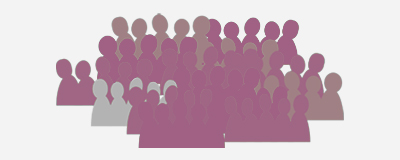
Example 1 is specific and collegial, and expresses the reason for the student’s frustration. Example 2 is vague, not collegial, and does not address the specific reason for frustration. Academic pressures can make group work challenging. In positive group communication, it is important to be clear, open-minded, calm, and, above all, respectful.